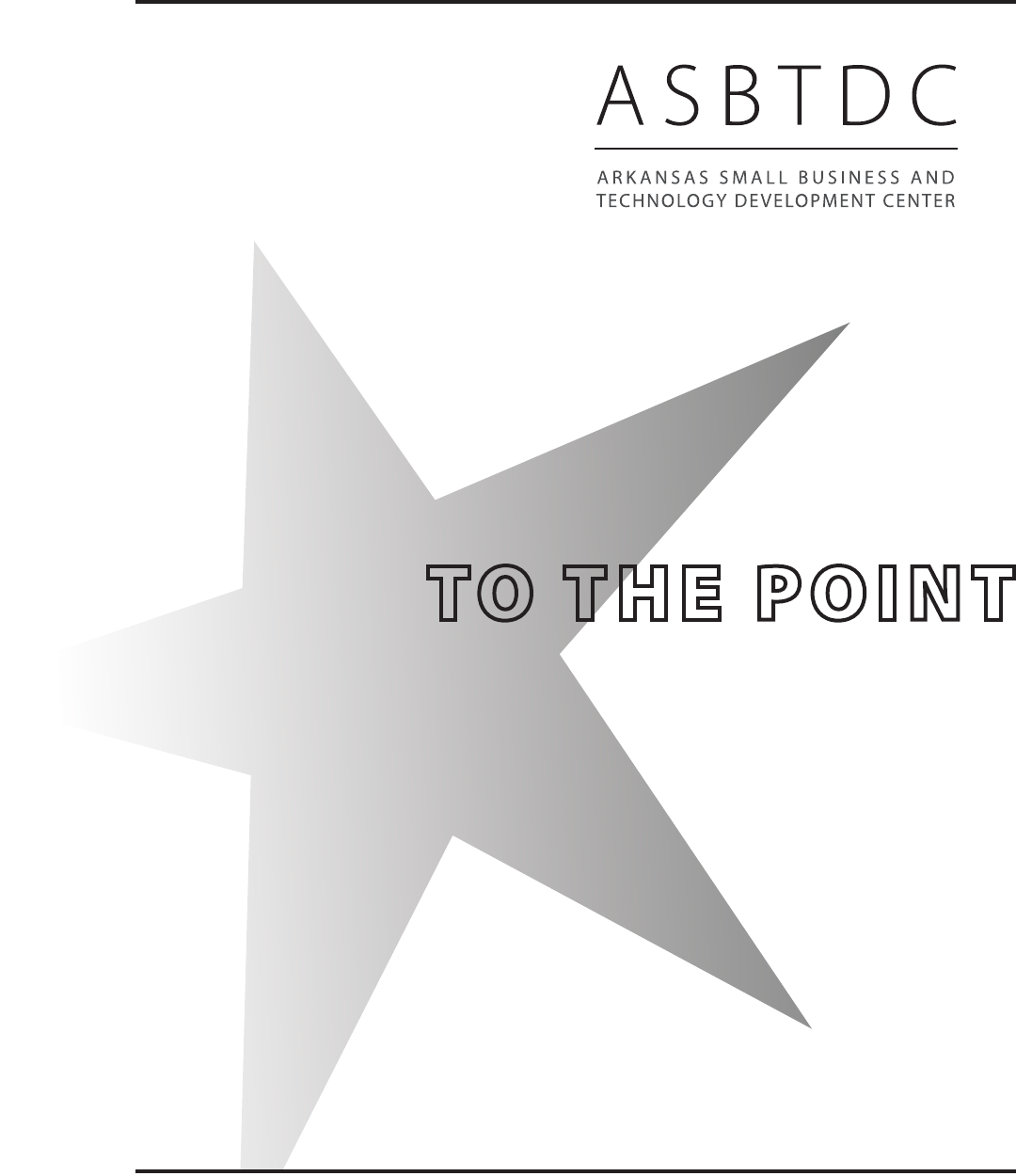
TO THE POINT
BUSINESS PLAN
OUTLINE
ARKANSAS SMALL BUSINESS AND TECHNOLOGY DEVELOPMENT CENTER

TO THE POINT BUSINESS PLAN OUTLINE
A business plan is a vital tool that will help you organize and develop your ideas and goals.
The To the Point Business Plan Outline streamlines and simplies the process of writing a
business plan. Though every business is unique, the ve sections (points) in the outline are
essential to your business plan no matter what type of business you plan to start.
The questions in this outline are designed to guide you as you create your plan. The Arkansas
Small Business and Technology Development Center can assist you with compiling your
answers into narrative form as they will appear in your completed business plan.
Your Products/
Services
Your Market
The Industry
Operations
and Management
Your Budget
Summary
Copyright 2018 by Arkansas Small Business and Technology Development Center.
All rights reserved.

All Points
Summary
Copyright 2018 by Arkansas Small Business and Technology Development Center.
All rights reserved.
TO THE POINT BUSINESS PLAN OUTLINE
Your executive summary is exactly that: a summary. You want this section to be concise,
pinpointing the highlights – your goals, objectives, and monetary needs – in an enthusiastic
fashion that captures the interest of your audience. The rest of your business plan gives the
details; this section oers highlights of what to expect from the rest of the document.
Write your summary last. The summary customarily appears at the beginning of your
completed business plan. However, you will need information from the rest of the business
plan in order to write it, so be sure that composing the summary is your last step.
• What type of business are you planning to start (or expand)?
• Where will the business be located?
• Who will be the owner(s), and what will be the legal structure?
• What is the total cost to start/expand your business (include amount needed for
equipment, inventory, furniture/xtures, supplies, startup-related expenses, buildings
or improvements, and working capital)?
• How much money are you contributing towards the total project costs?
• How much are you trying to borrow?
• What are you oering as collateral for your loan?

Point 1
Your Products/Services
TO THE POINT BUSINESS PLAN OUTLINE
You must clearly identify the type of business as well as the products and services you will oer.
You may say “that’s obvious!” but in taking the time to collect your thoughts and write down
your ideas, you may discover problems you had not anticipated and advantages you had not
considered.
• What are the business’s products or services?
• Where are those products/services sold (storefront, online, oce space, etc.)?
• What is the pricing structure for your products/services and how do you determine
your prices?
• What problem or need is your product/service solving?
Copyright 2018 by Arkansas Small Business and Technology Development Center.
All rights reserved.

Point 2
Your Market
TO THE POINT BUSINESS PLAN OUTLINE
Without customers, you cannot have a business. Yet many companies know next to nothing
about the people or businesses that purchase their products or services. As a business owner,
you need to know two things about your potential customers: what characteristics they have
in common and how many of them are in your target area. Identifying competitors is the
next step in analyzing your market. Consider both direct and indirect competition. When
you know who your audience is, you can create a marketing strategy to best pinpoint that
particular demographic.
• Who are your target customers?
• How many potential customers are in your trade area?
• Discuss the competition for your product/service within your trade area.
• Who are your direct and indirect competitors?
• What sets your business apart from the competition? In other words, why would
someone choose to buy from you rather than the competition?
• What are the best ways to market to your target customers?
• List your main 5-7 marketing tactics. (Be specic.) How much will each cost?
Copyright 2018 by Arkansas Small Business and Technology Development Center.
All rights reserved.

TO THE POINT BUSINESS PLAN OUTLINE
Point 3
The Industry
As a business owner, you must know your industry. Regularly reviewing industry trade
journals, publications and websites is a good idea. Other possible sources of information
are national or regional trade associations for your type of business.
• What trends and issues are facing the industry as a whole?
• What are some of the biggest problems the industry is facing?
• What opportunities exist in the industry?
Copyright 2018 by Arkansas Small Business and Technology Development Center.
All rights reserved.

TO THE POINT BUSINESS PLAN OUTLINE
Point 4
Operations and Management
The operation plan details the day-to-day “whos, whats, and wheres” for eectively operating
the business and illustrates to investors and lenders that you know how to run the business
and deliver your product or service. One of the most critical, yet most intangible, requirements
for a successful business is the management skill to control and direct the business once it is
operating.
• What is the owner’s role in business operations?
• Identify the number of employees required, their basic job functions, and their wages.
• What operational issues aect the business?
• How and when do customers pay?
• For existing businesses, what have you learned about operating your business
successfully?
Copyright 2018 by Arkansas Small Business and Technology Development Center.
All rights reserved.

TO THE POINT BUSINESS PLAN OUTLINE
Point 5
Your Budget
Developing a12-month operating budget is critical, whether you are starting or expanding.
Business owners incur many costs. Some of these expenses are of a continuing nature, such
as rent, utilities, and insurance. Others will be nonrecurring, such as equipment purchases,
security deposits, and the like. Be conservative and realistic as you develop your operating
budget. It is much better to outperform your projections than to try to explain why you
didn’t meet them – especially if you must explain that to your banker.
Obtain reliable estimates wherever possible. For example, public utility companies can give
you estimates on monthly bills for your proposed location.
If you’re a startup, keep in mind that it typically takes longer than anticipated for sales lev-
els to reach expectations. In a startup environment, it takes time for customers to nd out
about your business, decide to give you the opportunity to sell to them, and nally make a
purchase. Existing businesses entering new markets may have similar experiences.
Project Cost Summary
Equipment ___________________
Furniture/Fixtures ___________________
Inventory ___________________
Supplies ___________________
One-Time Fees and Deposits ___________________
Building or Improvements ___________________
Working Capital ___________________
Debt Renancing ___________________
TOTAL ___________________
Copyright 2018 by Arkansas Small Business and Technology Development Center.
All rights reserved.
(Existing businesses only)

TO THE POINT BUSINESS PLAN OUTLINE
Point 5
Your Budget
Budget Explanation
• How did you determine your monthly sales projections?
• How did you determine your monthly expense projections?
• Discuss other factors in the business that are expected to inuence your budget and
cash ow.
• For existing businesses, explain any dierences between historical performance and
future projections.
Include Monthly Cash Flow and Income Statement Projections for at least one year.
Copyright 2018 by Arkansas Small Business and Technology Development Center.
All rights reserved.

TO THE POINT BUSINESS PLAN OUTLINE
Supporting Documents
• Personal Financial Statement
• Resumé
• Price Quotes or Estimates on Planned Large Purchases (if applicable)
• Collateral List
• Historical Financial Statements (existing businesses only)
• Tax Returns (existing businesses only)
Copyright 2018 by Arkansas Small Business and Technology Development Center.
All rights reserved.

ASBTDC Offices
Lead Center
LITTLE ROCK
University of Arkansas at Little Rock
College of Business
Donald W. Reynolds Center for Business
& Economic Development
Suite 260
2801 S. University Ave.
Little Rock, AR 72204
501.683.7700
asbtdc.org
Regional Offices
ARKADELPHIA
Henderson State University
School of Business
870.230.5184
FAYETTEVILLE
University of Arkansas, Fayetteville
Sam M. Walton College of Business
479.575.5148
JONESBORO
Arkansas State University
Neil Griffin College of Business
870.972.3517
MAGNOLIA
Southern Arkansas University
David F. Rankin College of Business
870.235.4007
MONTICELLO
University of Arkansas at Monticello
870.460.1910
RUSSELLVILLE
Arkansas Tech University
College of Business
479.356.2067
The Arkansas Small Business and Technology Development Center is funded in part through a cooperative agreement with the U.S.
Small Business Administration through a partnership with the University of Arkansas at Little Rock College of Business and other
institutions of higher education. All programs are extended to the public on a non-discriminatory basis.
We hope you nd this outline helpful. Be certain to also review our To the Point Business Plan Sample as
you work on your plan. Once you have a draft plan, contact the Arkansas Small Business and Technology
Development Center near you for an appoinrtment. Our sta can review your plan and provide guidance
as well as answer questions.
Call On Us
COLLEGE OF BUSINESS
U
niversity
of
A
rkAnsAs
At
L
ittLe
r
ock
